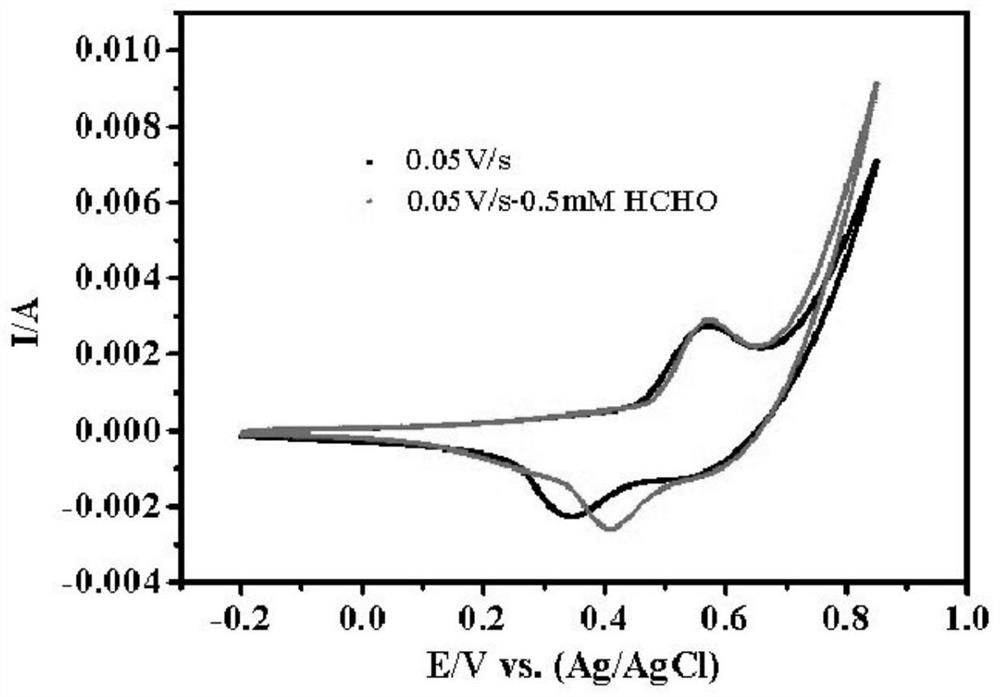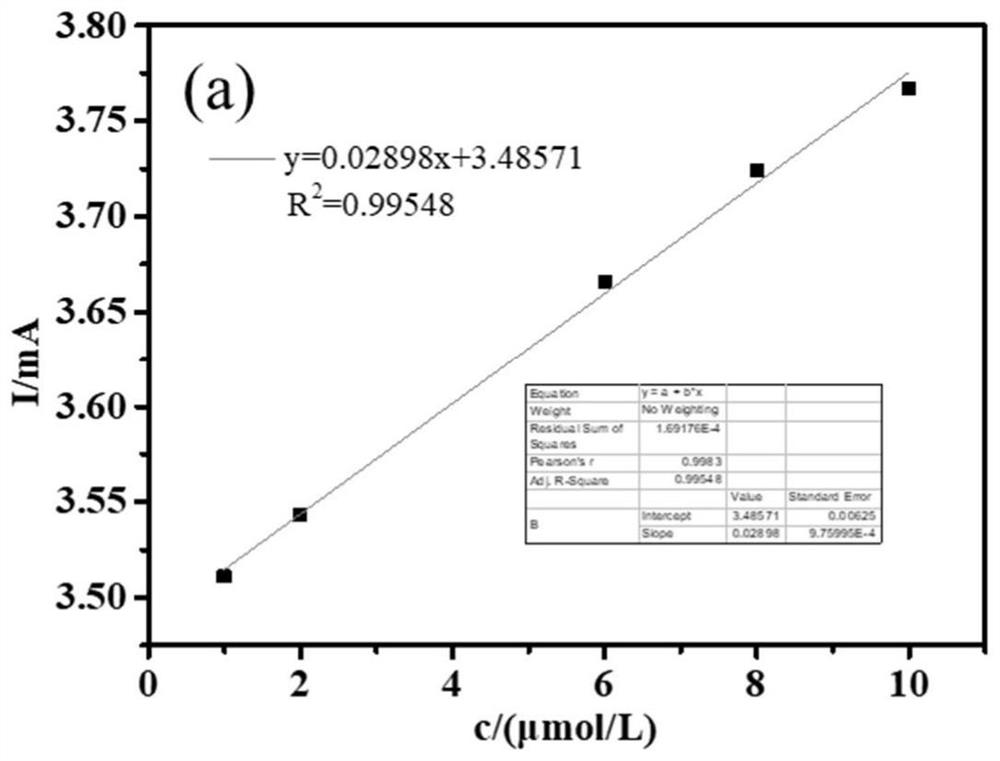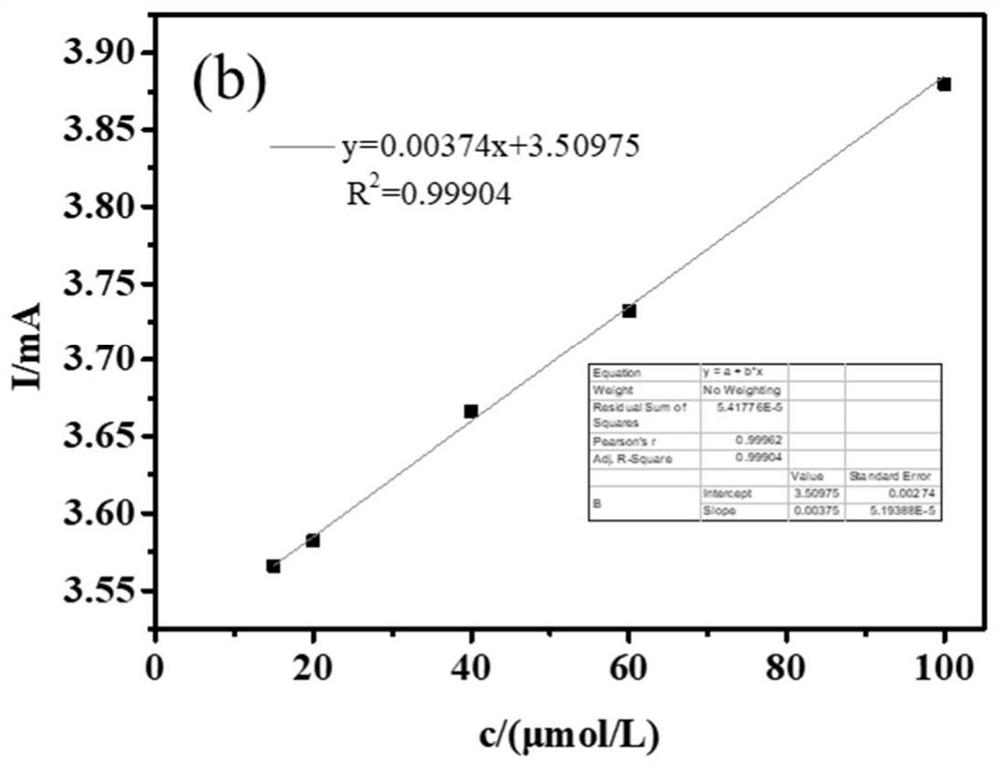Method for detecting formaldehyde in environmental water using carbon-foam copper material as working electrode
A technology for detecting environment and working electrodes, applied in the field of electrochemical analysis and detection, can solve the problems of unstable electrode performance, slow detection process, low detection sensitivity, etc., and achieve the effects of good reproducibility, fast analysis speed and low detection cost
- Summary
- Abstract
- Description
- Claims
- Application Information
AI Technical Summary
Problems solved by technology
Method used
Image
Examples
Embodiment 1
[0031] This embodiment provides a method for preparing a carbon-copper foam material as a highly sensitive formaldehyde sensor, comprising the following steps:
[0032] S1: 1g of graphite, concentrated H 2 SO 4 、H 3 PO 4 The three are placed in a three-necked beaker, and the concentrated H 2 SO 4 、H 3 PO 4 The volume ratio of the solution was 9:1, and 6 g of potassium permanganate was added in portions, and stirred for 1 h in an ice-water bath. The temperature was raised to 50°C, and the reaction was kept for 12 hours. Pour the obtained product into ice water, add an appropriate amount of hydrogen peroxide until the solution turns golden yellow, filter, and wash the product until the pH is close to 7. The graphene oxide solution was prepared by the improved hummers method, and after the preparation was completed, it was stored in the dark at room temperature for later use;
[0033] S2: Cut the foamed copper material into strips of 1cm×10cm. After the surface is ultrason...
Embodiment 2
[0041] This embodiment provides a method for preparing a carbon-copper foam material as a highly sensitive formaldehyde sensor, comprising the following steps:
[0042] S1: 1g of graphite, concentrated H 2 SO 4 、H 3 PO 4 The three are placed in a three-necked beaker, and the concentrated H 2 SO 4 、H 3 PO 4 The volume ratio of the solution was 9:1, and 6 g of potassium permanganate was added in portions, and stirred for 1 h in an ice-water bath. The temperature was raised to 50°C, and the reaction was kept for 12 hours. Pour the obtained product into ice water, add an appropriate amount of hydrogen peroxide until the solution turns golden yellow, filter, and wash the product until the pH is close to 7. The graphene oxide solution was prepared by the improved hummers method, and after the preparation was completed, it was stored in the dark at room temperature for later use;
[0043] S2: Cut the foamed copper material into strips of 2cm×12cm. After the surface is ultras...
Embodiment 3
[0051] This embodiment provides a method for preparing a carbon-copper foam material as a highly sensitive formaldehyde sensor, comprising the following steps:
[0052] S1: 1g of graphite, concentrated H 2 SO 4 、H 3 PO 4 The three are placed in a three-necked beaker, and the concentrated H 2 SO 4 、H 3 PO 4 The volume ratio of the solution was 9:1, and 6 g of potassium permanganate was added in portions, and stirred for 1 h in an ice-water bath. The temperature was raised to 50°C, and the reaction was kept for 12 hours. Pour the obtained product into ice water, add an appropriate amount of hydrogen peroxide until the solution turns golden yellow, filter, and wash the product until the pH is close to 7. The graphene oxide solution was prepared by the improved hummers method, and after the preparation was completed, it was stored in the dark at room temperature for later use;
[0053] S2: Cut the foamed copper material into strips of 3cm×15cm, and after the surface is ul...
PUM
| Property | Measurement | Unit |
|---|---|---|
| pore size | aaaaa | aaaaa |
| melting point | aaaaa | aaaaa |
| boiling point | aaaaa | aaaaa |
Abstract
Description
Claims
Application Information
 Login to View More
Login to View More - R&D
- Intellectual Property
- Life Sciences
- Materials
- Tech Scout
- Unparalleled Data Quality
- Higher Quality Content
- 60% Fewer Hallucinations
Browse by: Latest US Patents, China's latest patents, Technical Efficacy Thesaurus, Application Domain, Technology Topic, Popular Technical Reports.
© 2025 PatSnap. All rights reserved.Legal|Privacy policy|Modern Slavery Act Transparency Statement|Sitemap|About US| Contact US: help@patsnap.com



